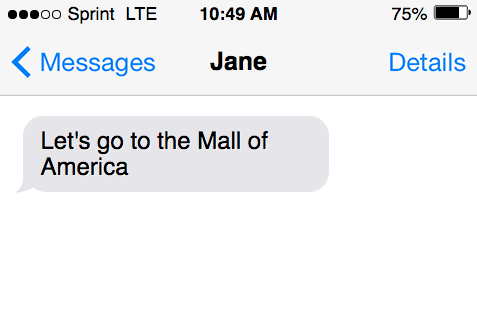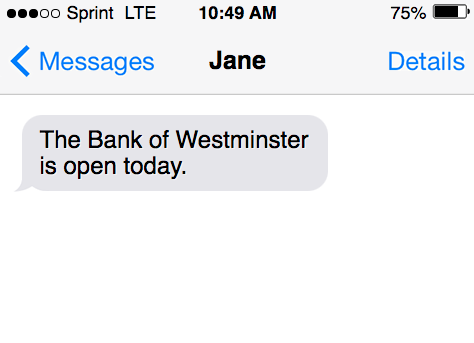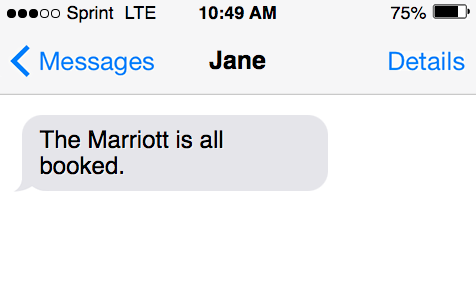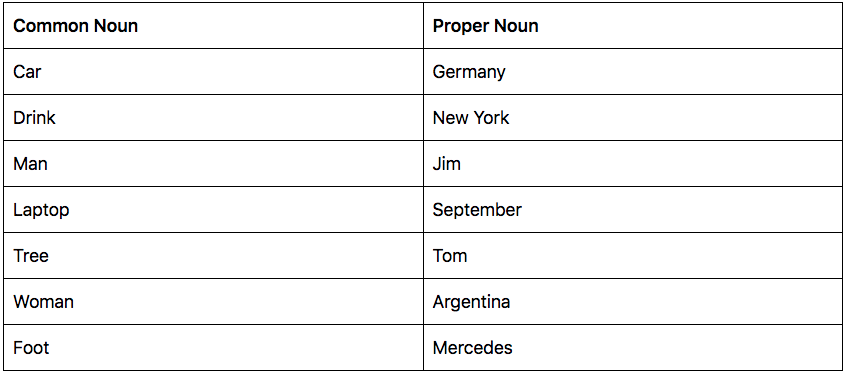Proper nouns are an essential element of the English language. They also play a critical element in all other worldwide languages but are referred to by parts of speech. They are one of the primary elements of language and grammar that need to be mastered before learning the more complex language concepts.
What is a proper noun?
A proper noun refers to a specific word or name given to a person, place, or thing. A proper noun includes, within its scope, the names of individuals, companies, and places. An essential thing to remember about proper nouns is that these words always start with the capital first letter. If a proper noun is spelled in all lowercase letters, it will be grammatically incorrect.
| Form | Definition |
| Proper noun | a word or group of words (such as “Noah Webster,” “Kentucky,” or “U.S. Congress”) that is the name of a particular person, place, or thing and that usually begins with a capital letter. |
Proper noun examples
To better illustrate this, let’s look at some examples of proper nouns:
- John is a deputy manager at Sony.
- The capital of India is Delhi.
- The world’s largest producer of android smartphones is Samsung, a South Korea-based multinational conglomerate.
- Today is a very important match between Arsenal and Chelsea FC.
- My favorite car brand is Ferrari.
Proper noun relationships to common nouns
Nouns are of various types. Proper nouns, common nouns, and concrete nouns are the most essential of all. Proper nouns, as established, are a type of noun used to refer to a specific person, place, or other entity. On the other hand, a common noun is a generic name to refer to a person, place, or thing. Common nouns are used to refer to a class of things.
For instance, the words: books, birds, girl, women, father, boys, and palace; are examples of Common nouns.
| Common Noun | Proper Noun |
| Car | Germany |
| Drink | New York |
| Man | Jim |
| Laptop | September |
| Tree | Tom |
| Woman | Argentina |
| Foot | Mercedes |
Alternatively, the following are examples of proper nouns:
- Sarah
- Jonathan
- The Buckingham Palace
- London
- England
Types of proper nouns
Proper nouns are often confused with pronouns and prepositions. This leads them to be classified into 6 main categories.
The next time you see any of the following categories be referred to as proper nouns, know that they are either pronouns or related to prepositions and not proper nouns.
Subject
There is no such thing as a subject proper noun. Subject pronouns are often confused and referred to as subject proper nouns. However, these are part of the pronoun speech and are related to verb performance. These are words that perform an action.
Direct object
Similar to subject pronouns, there is also no such thing as a direct object proper noun. Direct objects are also related to the performance of verbs. However, contrary to proper subject nouns, these words receive action.
Indirect object
Continuing on the pattern above, indirect object proper nouns are also not a thing. Indirect object verbs are words that receive action from the direct object. This may sound confusing. However, let’s look at an example to understand this concept better:
- The teacher gave the students homework.
In this sentence, the word “homework” is the direct object.
What did the teacher give the students? Homework. Thus, homework is the direct object.
“Students,” on the other hand, are indirect objects in this sentence.
To whom did the teacher give homework? To the students.
Object of the preposition
The noun (or word/phrase acting as a noun) that joins a preposition to produce a prepositional phrase is known as the object of a preposition. The preposition affects or refers to the objects. Prepositions are followed by their objects, which link the object and the section of the sentence they are changing.
Predicate nominative
The noun or pronoun which follows a connecting verb is known as the predicate nominative (or a predicate noun). The subject of a sentence is given a new identity with these nouns. If the subject and the predicate nominative are switched, the phrase would still make sense and be grammatically correct.

Proper noun grammar rules
As with every part of speech, proper nouns are also regulated by specific grammar rules that must get followed at all times.
- Firstly, grammar rules dictate that a proper noun should always get used with the first letter capitalized. An exception is certain cases when the noun acts as a common noun instead of a proper noun.
- The second important rule determines when a proper noun can be used with the word “the.” Typically, the word “the” can only be used in specific cases, which would be grammatically incorrect outside of that scope. We will discuss this in further detail in the coming paragraphs.
Common noun and proper noun comparisons
Here are some comparisons of proper nouns versus common nouns:
- Common Noun: Books
Proper Noun: It Ends with Us
- Common Noun: Birds
Proper Noun: Falcon
- Common Noun: Dogs
Proper Noun: Husky
- Common Noun: Snacks
Proper Noun: Doritos
- Common Noun: Banks
Proper Noun: The Bank of America
Proper noun examples (with “the”)
Typically, proper nouns do not start with the word “the.” However, they can be under certain circumstances. Let’s look at proper noun examples starting with “the” to understand this better.
First names
First names are proper nouns that will never begin with the word “the”. Designations like “the king” or “the president” that come before the actual name can start with “the”. However, the name itself will not start with that letter.
Surnames
Surnames or family names can begin with the word “the.” Let’s look at some examples of the same:
- The Windors
- The Trumps
- The Clintons
- The Adams
- The Newtons
- The Smiths
Full names
Full names may be used with the word “the” preceding them in some instances. Some examples of the same are:
- The William Jones’
- The Brian Jeffords’
- The Jake Peraltas
- The Rosa Diaz’s
- The Chuck Boyle’s
- The Amy Santiago’s
Shops
Various shops’ names can start with the word “the.” Some of the most common examples are:
- The ambrosia store
- The Polka Boutique
- The Mall of America
- The House of AND

Banks
The names of banks can be preceded by the word “the.” Some examples of the same include:
- The Bank of America
- The Bank of France
- The Bank of India
- The Bank of Westminster

Hotels
Some hotel names that start with “the” include:
- The Hilton
- The Marriott
- The Hyatt
- The Burj-al arab
- The Four Seasons
- The Lemon Tree

Churches
Churches, too, can have their names started with the word “the.” Some examples of the same include:
- The Church of Mary and Jesus
- The Church of Our Lady of Fatima
- The Church of Our Savior Lord Jesus
- The Church of Jesus Christ Latter-day saints
- The Church of Our Lady of Immaculate Conception
States
Some examples of states starting with the word “the” are:
- The United Kingdom
- The United States of America
Republic
Some examples of Republics starting with the word “the” include:
- The Republic of France
- The Republic of India
Proper nouns with “the”
States:
Some examples of states or countries starting with “the” include:
- the United States of America
- the United Kingdom
- the Netherlands
- the Bahamas and the Maldives
Canals
Some examples of canals starting with the word “the” include:
- The Suez Canal
- The Panama Canal
- The Kiel Canal
- The Corinth Canal
Rivers
Some examples of rivers starting with the word “the” are:
- The Ganges
- The Thames
- The Hudson River
- The Han River
- The Indus River
Oceans
Some examples of oceans starting with the word “the” are:
- The Pacific ocean
- The Indian ocean
- The Arctic ocean
- The Atlantic ocean
People
Some example of people starting with the word “the” are:
- The King of England
- The President of the United States
- The Prime Minister of India
- The Prince of Wales
- The Princess of Wales
- The priest
Proper nouns ending in “s” possessive examples
In certain situations, proper nouns can end with an “s” and represent a possessive tone. A possessive tone refers to when a sentence shows ownership of an object.
Some examples of proper nouns ending in “s” are:
- Mary’s dog was very playful.
- London’s Buckingham Palace is a sight to appreciate.
- Martin’s ice cream shop serves the best swirl ice creams in town.
- Johnny’s bride is a real looker.
Common questions
There are a lot of questions commonly asked about proper nouns. Some of the most common ones include the following:
Is “mom” a proper noun?
No. The word “mom” is not a proper noun.
Is “earth” a proper noun?
Yes. The word “Earth” signifies a specific planet or place to live on. As such, it is a proper noun. This also means that the word “Earth” must start with a capitalized “E.” However, it can also be used as a common noun, which should be used with a lowercase ‘e.’
What is the proper noun of the word “teacher?”
The word “teacher” is a generic noun. There is no proper noun for the word. However, the teacher’s name would need to be used to make it a proper noun.
Let’s take a look at some examples;
- Ms. Martin
- Mr. Adams
- Mrs. Stephanie
- Mr. Benes
- Ms. Rifkin
What is the proper noun of the word “car?”
A proper noun for the word “car” would be the brand or name of the car itself—for example, Ferrari, Honda, etc.
What is the proper noun of the “country” or “countries?”
The words “country” and “country” represent a category of things. Hence, these words are not proper nouns
Examples
Some examples of proper nouns for country or countries are:
- India
- Zimbabwe
- Australia
- Africa
- London
- China
- South Korea
- Argentina
- Peru
What is the proper noun for the word “dog?”
The correct proper noun for the word dog can be the name of the dog like Bruno, Brandy, Pugsly, etc. Alternatively, the dog’s breed names can also be proper nouns, for example: Golden Retriever, Husky, German Shepherd, etc.

FAQs
Are proper and common nouns the same?
No, one is used to refer to people and the other is used to refer to places.
How can I tell the difference between common and proper nouns?
Common nouns are words for types of things, people, and places, such as “dog,” “teacher,” and “city.” They are not capitalized and are typically used in combination with articles and other determiners. Only proper nouns are capitalized.
What’s a simple way to understand a proper noun?
In English, proper nouns are words derived from a person’s name.
Are all proper nouns in capital letters?
Typically, yes.
Are cardinal directions proper nouns?
No. North, East, South, and West are common nouns.
How does the definite article work with proper nouns?
Some proper nouns have the definite article before the person’s name.
More on nouns
More resources about nouns:
- Possessive nouns
- Irregular plural nouns
- Proper nouns
- Concrete nouns
- Collective nouns
- Possessive and plural nouns
Sources
- What are proper nouns, How do I use them?
- Proper Noun- Merriam Webster
- 20 examples of Proper nouns in English
- Proper Noun
- What is a proper noun?
- Proper noun
- What is a proper noun: Definition and Usage
- Proper nouns and common nouns
- Possessive case of Noun
- Grammar Rules about Proper Nouns
Inside this article
Fact checked:
Content is rigorously reviewed by a team of qualified and experienced fact checkers. Fact checkers review articles for factual accuracy, relevance, and timeliness. Learn more.
Core lessons
Glossary
- Abstract Noun
- Accusative Case
- Anecdote
- Antonym
- Active Sentence
- Adverb
- Adjective
- Allegory
- Alliteration
- Adjective Clause
- Adjective Phrase
- Ampersand
- Anastrophe
- Adverbial Clause
- Appositive Phrase
- Clause
- Compound Adjective
- Complex Sentence
- Compound Words
- Compound Predicate
- Common Noun
- Comparative Adjective
- Comparative and Superlative
- Compound Noun
- Compound Subject
- Compound Sentence
- Copular Verb
- Collective Noun
- Colloquialism
- Conciseness
- Consonance
- Conditional
- Concrete Noun
- Conjunction
- Conjugation
- Conditional Sentence
- Comma Splice
- Correlative Conjunction
- Coordinating Conjunction
- Coordinate Adjective
- Cumulative Adjective
- Dative Case
- Determiner
- Declarative Sentence
- Declarative Statement
- Direct Object Pronoun
- Direct Object
- Diction
- Diphthong
- Dangling Modifier
- Demonstrative Pronoun
- Demonstrative Adjective
- Direct Characterization
- Definite Article
- Doublespeak
- False Dilemma Fallacy
- Future Perfect Progressive
- Future Simple
- Future Perfect Continuous
- Future Perfect
- First Conditional
- Irregular Adjective
- Irregular Verb
- Imperative Sentence
- Indefinite Article
- Intransitive Verb
- Introductory Phrase
- Indefinite Pronoun
- Indirect Characterization
- Interrogative Sentence
- Intensive Pronoun
- Inanimate Object
- Indefinite Tense
- Infinitive Phrase
- Interjection
- Intensifier
- Infinitive
- Indicative Mood
- Participle
- Parallelism
- Prepositional Phrase
- Past Simple Tense
- Past Continuous Tense
- Past Perfect Tense
- Past Progressive Tense
- Present Simple Tense
- Present Perfect Tense
- Personal Pronoun
- Personification
- Persuasive Writing
- Parallel Structure
- Phrasal Verb
- Predicate Adjective
- Predicate Nominative
- Phonetic Language
- Plural Noun
- Punctuation
- Punctuation Marks
- Preposition
- Preposition of Place
- Parts of Speech
- Possessive Adjective
- Possessive Determiner
- Possessive Case
- Possessive Noun
- Proper Adjective
- Proper Noun
- Present Participle
- Prefix
- Predicate



